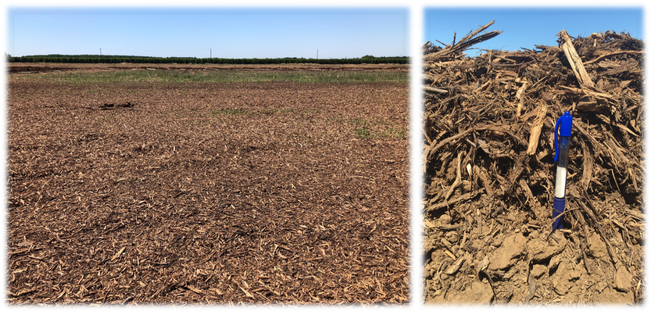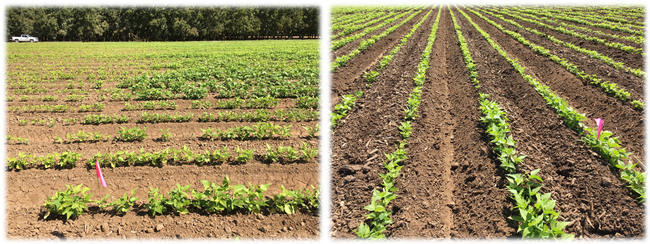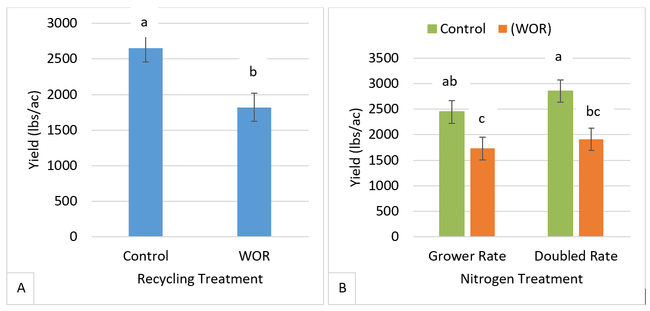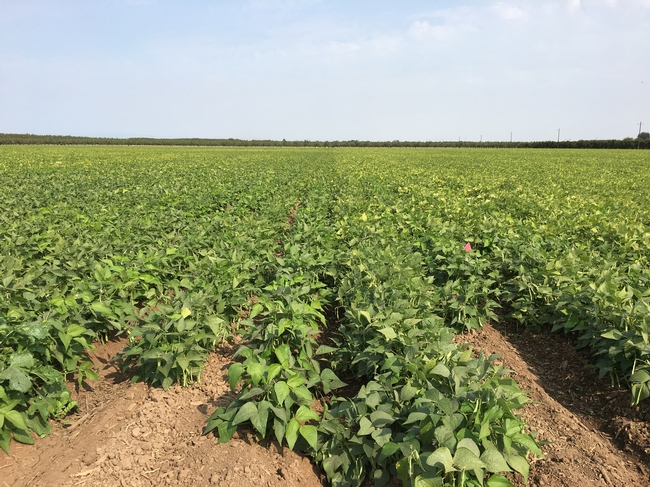In 2020, we established a trial to evaluate soil properties and kidney bean yield following whole orchard recycling of a walnut orchard. Whole Orchard Recycling (WOR) occurs after the productive life of an orchard and is the process of grinding or chipping trees, spreading the wood chips evenly over the soil surface, and then incorporating the biomass into the soil. WOR has become more common in recent years because air quality regulations restrict growers' ability to manage biomass by burning. Additionally, half of California's biomass power generation plants have closed, and those that still operate are no longer paying for wood chips.
While the process of WOR came about due to biomass management restrictions, researchers have been evaluating its potential benefits for soil health and water management. This is because the practice incorporates large quantities of organic carbon (C) into the soil, and soil C influences other soil properties. The California Department of Food and Agriculture (CDFA) Healthy Soils Program (HSP) now recognizes the practice in their incentives program and provides growers with up to $800 per acre for WOR. The San Joaquin Valley Air Pollution Control District also supports growers who recycle orchards with up to $600 per acre.
While there are benefits associated with incorporating large quantities of C into the soil, there are also tradeoffs. The woody biomass of the trees has a high carbon to nitrogen (C:N) ratio. The C:N ratio is the mass of C relative to the mass of N. It is an important characteristic of soil amendments because it influences soil biological activity. When the C:N is high, as it would be with woody biomass, the N is primarily used for microbial energy and maintenance. In other words, the N is ‘tied up' by the microbes and not available for plants.
Our understanding of nutrient cycling and availability is most advanced in almond WOR sites replanted back to almond. Previous research at WOR sites that were replanted back to almond found that doubling the N fertilizer recommendation in the first year could help to avoid reduced growth of the new orchard. We established this trial because more research is needed on WOR in other orchard systems, and when annual crops are subsequently planted rather than orchards. Our objectives were to evaluate soil properties and bean yield following WOR compared to a non-WOR control, and to evaluate two N fertilizer rates. We hypothesized that bean yield might be compromised following WOR due to N immobilization but that a higher rate of N fertilizer might overcome the yield gap.
The trial took place on an approximately 35-acre site near Linden, following the June 2019 walnut orchard recycling that incorporated approximately 70 tons of wood chips per acre (Figure 1). At that time, three approximately 0.5-acre plots were kept without wood chips, as ‘untreated controls'. We then identified three 0.5-acre WOR plots adjacent to each control plot.
Figure 1. Recycled orchard site showing wood chips spread over the field and the depth of wood chips applied.
More information about our procedures can be found in the full report, available from https://ucanr.edu/sites/deltacrops/files/352144.pdf. Soils were sampled three times during the season to inform our fertilizer rates and understand C and N cycling. The UC production manual for dry beans indicates that a bean crop that yields 2000 lb/acre needs approximately 80-120 lb of N to grow the crop. While beans are a legume and can fix atmospheric N and turn it into plant-available N, they do not fix enough to satisfy their own N requirement. They fix about 20-40 percent of their need. Nitrogen inputs for the trial are listed in Table 1. The beans were planted on July 10th and harvested on October 19th.
Table 1. Nitrogen inputs in 2020 trial.
Soil samples were evaluated for organic C, total N, and nitrate-N. With the pre-plant samples collected in June, there were no differences in organic C, total N, or nitrate-N between the WOR treatment and control. Total organic C averaged 1.2 percent across all plots, total N averaged 1052 ppm, and nitrate-N averaged 2.78 ppm. In August, prior to sidedress N application, we observed differences in plant size, with plants in the WOR treatments being smaller than those in the control plots (Figure 2).
Figure 2. Bean plants in August 2020, prior to sidedress N application, where plants in the WOR treatment were observably stunted compare to those in the control plots where no wood chips were previously incorporated. A) Plants to the right of the pink flag in the foreground are in a control plot. B) Bean plants in the foreground near the pink flag are in a control plot.
By October, soil organic C, total N, and nitrate-N differed among treatments. (See full report for graphed data.) Organic C and total N were significantly higher in the WOR treatment compared to the control, and neither had differences between the N fertilizer treatments. Nitrate-N, however, had an opposite result. It was significantly higher in the control compared to the WOR treatment, and there were differences between fertilizer rates, with the lowest nitrate being in the grower N rate plots of the WOR treatment. The soil results suggest that, by October, the wood chips were decomposing and contributing to the soil organic C and N pools. The organic N, however, was not yet mineralizing to nitrate. Nitrate was limited in the WOR treatment, where it was possibly tied up by soil microbes, unless boosted by the doubled sidedress fertilizer rate.
Whole orchard recycling and nitrogen fertilizer rate impacted yield in this trial. Yield was statistically higher in the control plots, averaging 2652 lb/ac across replicates, compared to the WOR plots where the average was 1820 lb/ac (Figure 3A). There were also differences in yield among N fertilizer rates (Figure 3B). In the control, the grower N rate and the doubled N rate performed statistically similar. In other words, there was no benefit to applying the doubled sidedress rate in the control. Additionally, the grower rate in the control performed statistically similar to the doubled rate in the WOR treatment. This indicates that while WOR may tie up N – limiting its availability for plant growth and yield – doubling the recommended N rate overcame the yield penalty imposed by WOR. Thus, when coupled with additional N fertilizer, WOR can augment soil health properties, like organic C and N, without penalty to yield.
Figure 3. Bean yield in October 2020 averaged across three replicated blocks. A) Bean yield between WOR treatment and the control were statistically different. B) Bean yield for N fertilizer rates were also statistically different. Bean moisture averaged 10.5 percent across all treatments.
Summary:
This project evaluated soil properties and kidney bean yield following walnut WOR. By incorporating a large quantity of organic C into the soil, WOR has the potential to improve soil health properties, but a tradeoff may be that N becomes limited for subsequent crops. We found organic C and N to increase with WOR from the beginning of the bean season to the end, but plant-available nitrate was limited by WOR. Bean yield suffered as a result of WOR, but doubling the fertilizer N recommendation mitigated the yield penalty. Under the circumstances of this trial, a total N rate of just over 200 lb/ac maintained bean yield where WOR had been implemented compared to the control plots with no wood chips. It does appear, however, that the yield in the WOR treatment might have benefitted from an even higher rate of N. To our knowledge, this trial was the first of its kind and more research will be needed to develop N fertility guidelines in dry beans following WOR. Other tree and annual crops should also be studied. We will continue this trial in 2021 to evaluate whether the impacts of WOR continue in the second season after recycling.
Attached Images:




